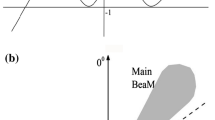Abstract
The growth of wireless communication continues. There is a demand for more user capacity from new subscribers and new services such as wireless internet. In order to meet these expectations new and improved technology must be developed. A way to increase the capacity of an existing mobile radio network is to exploit the spatial domain in an efficient way. An antenna array adds spatial domain selectivity in order to improve the Carrier-to-Interference ratio (C/I) as well as Signal-to-Noise Ratio (SNR). An adaptive antenna array can further improve the Carrier-to-Interference ratio (C/I) by suppressing interfering signals and steer a beam towards the user. The suggested scheme is a combination of a beamformer and an interference canceller.
The proposed structure is a circular array consisting of K omni-directional elements and combines fixed beamforming with interference cancelling. The fixed beamformers use a weight matrix to form multiple beams. The interference cancelling stage suppresses undesired signals, leaking into the desired beam.
The desired signal is filtered out by the fixed beamforming structure. Due to the side-lobes, interfering signals will also be present in this beam. Two alternative strategies were chosen to cancel these interferers; use the other beamformer outputs as inputs to an adaptive interference canceller; or regenerate the outputs from the other beamformer outputs and generate clean signals which are used as inputs to adaptive interference cancellers.
Resulting beamformer patterns as well as interference cancellation simulation results are presented. Two different methods have been used to design the beamformer weights, Least Square (LS) and minimax optimisation. In the minimax optimisation a semi-infinite linear programming approach was used. Although the optimisation plays an essential role in the performance of the beamformer, this paper is focused on the application rather then the optimisation methods.
Similar content being viewed by others
References
S. Andersson, M. Millnert, M. Viberg and B. Wahlberg, An adaptive array for mobile communication systems, IEEE Transactions on Vehicular Technology 40 (1991) 230–236.
E.J. Anderson and P. Nash, Linear Programming in Infinite-Dimensional Spaces(Wiley, New York, 1987).
X. Chen and T.W. Parks, Design of FIR filters in the complex domain, IEEE Transactions on Acoustics, Speech, and Signal Processing 35(2) (1987) 144–153.
I. Claesson and S. Nordholm, A spatial filtering approach to robust adaptive beamforming, IEEE Transactions on Antennas and Propagation 40(9) (1992) 1093–1096.
M.H. Er and A. Cantoni, A unified approach to the design of robust narrow-band antenna array processors, IEEE Transactions on Antennas and Propagation 38(1) (1990) 17–23.
M.A. Goberna and M.A. López, Semi-Infinite Linear Optimization, Wiley Series in Mathematical Methods in Pratice 2 (Wiley, Chichester, England, 1998).
L.J. Griffiths and C.W. Jim, An alternative approach to linearly constrained adaptive array processing, IEEE Transactions on Antennas and Propagation 30(1) (1982) 27–34.
S. Haykin, Digital Communication(Wiley, 1988).
S. Haykin, Adaptive Filter Theory(Prentice-Hall, 1996).
S. Ito, Y. Liu and K.L. Teo, A dual parameterization method for convex semi-infinite programming, in: Optimization Techniques and Applications, eds. L. Cacetta et al. (1998) pp. 558–565.
J. Litva and T.K. Lo, Digital Beamforming in Wireless Communications(Artec House, 1996).
D.G. Luenberger, Linear and Nonlinear Programming(Addison-Wesley, 1984).
S. Nordebo, I. Claesson and S. Nordholm, Adaptive beamforming: spatial filter designed blocking matrix, IEEE Journal of Oceanic Engineering 19(4) (1994) 583–590.
S. Nordebo and Z. Zang, Semi-infinite linear programming: A unified approach to digital filter design with time and frequency domain specifications, IEEE Transactions on Circuits and Systems-II: Analog and Digital Signal Processing 46(6) (1999) 765–775.
J.G. Proakis, Digital Communications(McGraw-Hill, 1995).
Author information
Authors and Affiliations
Rights and permissions
About this article
Cite this article
Nordholm, S., Nordberg, J., Claesson, I. et al. Beamforming and Interference Cancellation for Capacity Gain in Mobile Networks. Annals of Operations Research 98, 235–253 (2000). https://doi.org/10.1023/A:1019212625167
Issue Date:
DOI: https://doi.org/10.1023/A:1019212625167




